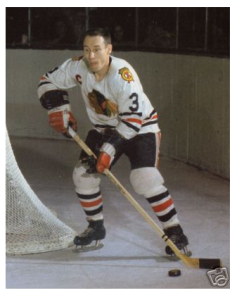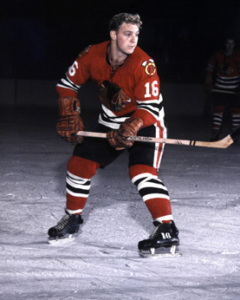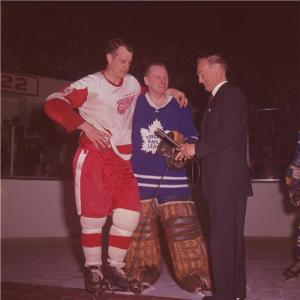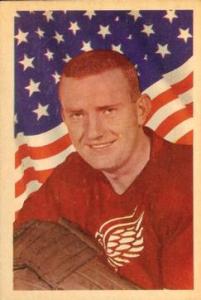So here we are in the waning days of the Summer of ’64, our most hockey-free season dragging on inexorably towards its inevitable conclusion. And with the impending change of season, that most curious of mammals, the puckster, begins to stir from its warm-weather hibernation in anticipation of another winter frolicking on a frozen pond near you. The dead giveaway to the rise of the puckster is the fact that all six NHL training camps are now underway, a ritual that has been repeated yearly at this time for decades.
The puckster is truly a unique creature, especially among those who are hibernatory. While bears, snakes and others pass their winters in a deep, deep sleep, the puckster thrives, choosing instead to spend the heat of the summer dozing peacefully, regrouping and gathering strength for the harsh cold season that lies ahead.
The puckster is indigenous to the Northeastern United States, and the St. Lawrence region of Canada, but can also be found as far west as Lake Michigan in good numbers. Smaller enclaves can be found throughout North America, although none of these is as significant as those in the major regions mentioned above.
While the species is commonly know by the moniker “puckster”, it can also be designated by one of several sub-species, every one with its own unique characteristics, yet all strangely similar. These sub-species, each of which we will examine in detail, are:
- The norris
- The artross
- The hart
- the byng
- the vezina
All of these groups share common traits – they are territorial in nature, often fiercely so. They are able to co-exist and even cooperate for their communal well-being with the other sub-species. Pucksters are also tribal in nature, roaming in packs numbering less than 20, consisting of at least one of each of the sub-species, working together for the common good of the pack.
Sub-species
The norris: Often larger in size than the other groups, the norris seems drawn more to protecting the lair, and keeping other packs from invading and otherwise doing harm to the home pack or the lair. While the norris will hunt, those occasions are not frequent and often fail to provide worthwhile results. Common traits of the norris are that they are brutish in nature, and usually able to inflict great physical harm upon enemies. They are slow afoot and are considered to be not as intelligent as the other sub-species, but evolution seems to be leading them on a more cerebral path.

The artross: Mainly known as the breadwinner of the species, the artross is not normally found close to the lair. The artross has a singular purpose of foraging for sustenance , and taking care of the needs of the pack. The artross normally returns to the lair only at the end of the day, hopefully after a successful hunt. While not normally as brutish as the norris, the artross achieves its success by various means, and can be a fighter, or one that achieves its goal by more subtle means.

The hart: This is truly the alpha-male. Usually the dominant member of the pack, he is often the fastest, strongest, most intelligent and commonly the best looking pack member. There is normally only one or possibly two harts in a pack. A pack without a hart usually has a great deal of difficulty with survival and often will be forced into hibernation early in the spring.

The vezina: The vezina is the most nimble, intelligent and resourceful of the sub-species, and generally combines the best traits of all others. The Vezina guards the lair and is never entrusted with foraging duties. The vezina is a distant cousin to the armadillo, and is well fortified, and can withstand exteme amounts of punishment. The vezina is generally held in high esteem by the rest of the pack and is very well-respected.
The byng: The byng is also usually nimble and a graceful hunter, preferring to vanquish its enemies with wit and guile rather than by brute force or direct confrontation. A byng can be a very important presence for the pack, but it is generally believed that a pack with too many byngs can be easily dominated and usually will not experience long-term survival.
The puckster exhibits other traits that are mystfying. The pack often orders a member out of the group and even designates to which pack the expelled puckster must move. Zoologists feel that the puckster yearns to be free to move from pack to pack at will, yet it seems to be an inalienable law of nature that keeps the puckster inextricably linked to one pack until banished.
So, as the weather cools and the pucksters awaken, keep an eye out for them. They are extremely competitive and seem to thrive when they realize they are being observed. Studying the puckster in its natural habitat can be thrilling, rewarding and most entertaining – don’t miss out when the opportunity presents itself!
Training camp notes
News and notes from the first week of NHL training camps:
- Chicago Black Hawks held a rookie camp in St. Catharines, Ontario, which attracted 110 players from Ontario, Quebec and the Maritimes. Twenty-two of those players have been invited back for the Hawks’ main camp. Some of those making their first appearance at an NHL training camp include Bob Sicinski of the Dixie Beehives, Paul Terbenche from Port Hope, Ontario, Wayne Maki of Sault Ste Marie, Ontario, Maurice L’Abbe of Montreal and a fourteen year old goaltender from Milton by the name of Peter McDuffe.
- Gordie Howe, Alex Delvecchio and Doug Barkley are the first Red Wings to sign their 64-65 contracts. Big Gord is apparently the highest paid NHL worker with a salary in the $30,000 bracket.

- George (Punch) Imlach, GM-Coach of the Toronto Maple Leafs, says that he will station assistant GM King Clancy at a point half-way between the team’s Peterborough hotel and the practice rink, to ensure that players are making the required walk to the arena, instead of cheating and driving their cars.
- The Leafs are also employing an English figure skating coach to give the players skating tips during the early part of training camp.
- Ron Ellis is the rookie garnering most interest at Toronto’s camp, but King Clancy’s son Terry also has attracted attention. It’s thought that the younger Clancy will apprentice in the minors before getting a shot at the big-time.
- All eyes in the Detroit camp are on rookie goalie Roger Crozier, who was handed the Red Wings’ goaltending job when the team left Terry Sawchuk unprotected in the Intra-League draft and he was snatched up by Toronto.
- First New York Rangers to sign their contracts this fall are Rod Seiling and Jacques Plante. Seiling is the junior defenseman acquired by the Rangers in last February’s mammoth trade that sent Andy Bathgate and Don McKenney to Toronto.
- Toronto forward Red Kelly will be representing the government of Canada at the 1964 Summer Olympics in Tokyo. This is a source of consternation for Punch Imlach, since Kelly’s time abroad will be during part of the Leafs’ NHL schedule.
- Early in training camp Dickie Moore ,drafted by the Leafs from Montreal this summer, raised doubts that he would be able to come back from the knee woes that caused him to sit out last season. As camp has progressed, Moore has trained seriously and may yet be able to play for Toronto
- Ninety players have reported to Montreal’s training camp. Coach Toe Blake remarked “There’s not a fat guy among them.”
- Yvan Cournoyer, who scored four goals in a five game trial late last season, is given the best chance to replace the retired Bernie (Boob Boom) Geoffrion on right wing in Montreal.
- Boston’s Murray Balfour, acquired in a trade this summer from Chicago, has an injured knee and that has caused to the Bruins to explore more trade possibilities. Toronto has a surplus on the right side, but Boston doesn’t want to give up LW Dean Prentice, in whom the Leafs have expressed interest
- The Bruins picked up netminder Cesare Maniago from Montreal to back up regular goalie Ed Johnston. Terms of the transaction are not clear, but it is understood that Maniago is on loan to the Bruins and likely will end up with their Minneapolis farm team in the Central League.
- Milt Dunnell in the Toronto Star today wrote about the three Chicago Black Hawks who were dealt to Boston in the off-season. Dunnell described Reg Fleming, Ab McDonald and Murray Balfour as “The three angriest Indians since the massacre of General Custer”. He wrote that they were “Honing their tomahawks” at the Bruins camp.
- In eight days of scrimmaging at the Black Hawks camp, Bobby Hull has scored fourteen goals! NHL goaltenders reading this can’t be happy about the prospects of facing Hull’s vaunted slap shot once again this season.